

Thinking React. React Visual Studio. React Native. Props. Mantra. Learning. GraphQL. Flux. Component. Blog. Adding A Robust Form Validation To React Redux Apps. Adding A Robust Form Validation To React Redux Apps Form validation is vital because it helps with the UX.

It helps user know that there is something wrong with what they’ve entered or if they’ve missed something and so on. A “robust” form validation helps with (at least): Client-side Validation: e.g. Check empty fields, password length etc.Instant Server-side Validation: e.g. But implementing such a form validation is a lot of work in any framework including Redux apps. Use libraries 🎉😀! OK, Let’s see how to implement all those scenarios by taking using an example app.
Note: Click on the picture above to Zoom and read. Angular 2 versus React: There Will Be Blood. Angular 2 versus React: There Will Be Blood Angular 2 has reached Beta and appears poised to become the hot new framework of 2016.

Angular Directives Mapped to React. Ng-class React doesn’t provide something like ng-class, but there is a great library called classnames that does the same and more.
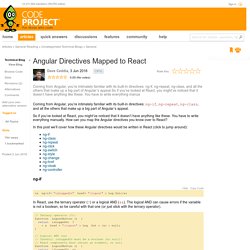
Install it: npm install classnames Import it however you like: import classNames from 'classnames' ; var classNames = require ( 'classnames' ); var cx = require ( 'classnames' ); Then it supports things like this (from their docs): Blog Posts. Compilation of open source/boilerplate React Meteor apps : Meteor. Dan Abramov - Live React: Hot Reloading with Time Travel at react-europe 2015. Dear Templating — Sincerely, JSX Part 1. Dear Templating — Sincerely, JSX Part 1 Surprisingly, the biggest complaint I hear about JSX is along the lines of It’s such a tight coupling to the DOM Well, not really, it is just a declarative syntax to describe components in a tree…Virtual?
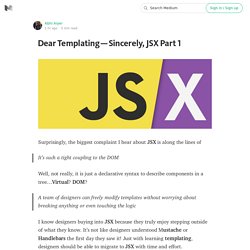
DOM? A team of designers can freely modify templates without worrying about breaking anything or even touching the logic I know designers buying into JSX because they truly enjoy stepping outside of what they know. If you’re a designer check out this article. You have to port/reimplement all the stuff that JavaScript has already solved to your templating language. Ding, Ding, Ding!
But First…They’re not so different… Templating and JSX are considered Domain Specific Languages (DSL). What is Templating? Templating refers to the client side method of binding data to views. How does this work? Enaqx/awesome-react: A collection of awesome things regarding React ecosystem. ES6 + React part 1. From Blaze to React 04: Layouts & Redirects.
We’re pushing forward in our quest to slim down our router code.
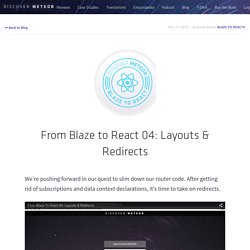
After getting rid of subscriptions and data context declarations, it’s time to take on redirects. Thinking About Redirects A “traditional” redirect sends the user to a new route, but a better and less disruptive pattern is to keep the URL the same, and instead just switch out the contents of the template. GitHub - yongxu/react-DnR. Hot Reloading in React. How we unit test React components using expect-jsx. React was designed to solve one problem—how to build applications with data that changes over time.
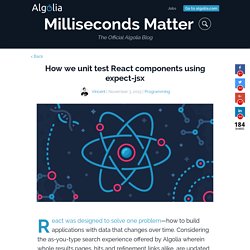
Considering the as-you-type search experience offered by Algolia wherein whole results pages, hits and refinement links alike, are updated at each keystroke, React was the obvious choice when we needed a tool to build out our new library of UI widgets: instantsearch.js. We quickly struggled, however, with the unit test best practices for React components. Is There Life on React Planet? - XB Software. When a new development technology gets your attention, many different criteria allow you to judge if it’s good enough for gaining benefits for your business.

Fast development speed, high-performance rate, good looking user interface, the possibility to develop applications that look and feel good on different devices. Depending on which feature is more crucial for you, you can prefer one programming language or library over the others. But here’s another important thing that you should not forget while choosing a suitable library for your project. The ecosystem. There’s no such thing as a silver bullet when we talk about the web development. The more ways of using React is available, the more issues you can solve with it. MobX: Ten minute introduction to MobX and React. MobX is a simple, scalable and battle tested state management solution.

This tutorial will teach you all the important concepts of MobX in ten minutes. The core idea State is the heart of each application and there is no quicker way to create buggy, unmanageable applications then by producing inconsistent state. Or state that is inconsistent with local variables that linger around. Hence many state management solutions try to restrict the ways in which you can modify state, for example by making state immutable.
MobX makes state management simple again by addressing the root issue: it makes it impossible to produce an inconsistent state. Conceptually MobX treats your application like a spreadsheet. First of all, there is the application state. A simple todo store... Enough theory, seeing it in action probably explains more that carefully reading the above stuff. Pourquoi pas ReactJS ? Productive Rage - Writing React apps using Bridge.NET - The Dan Way (from first principles) 15 March 2016 I've had a request from someone to write about how I think that someone from a .net background should write a web-based application.
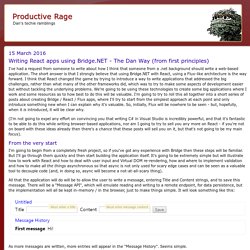
The short answer is that I strongly believe that using Bridge.NET with React, using a Flux-like architecture is the way forward. I think that React changed the game by trying to introduce a way to write applications that addressed the big challenges, rather than what many of the other frameworks did, which was to try to make some aspects of development easier but without tackling the underlying problems. React and the economics of dynamic web interfaces - NCZOnline. I've been doing web development since 2000, and in that time I've seen eras marked by libraries and frameworks come and go.

The Ajax era began around the same time as the jQuery era began, the Backbone era began several years later, and the React era really began about two years ago. Each of these eras brought with it a new realization about the way we can build dynamic web interfaces based on the tools available. jQuery made it clear that browser abstractions and CSS querying were important to developers, Backbone introduced the concept of client-side architecture to many, and React enables the creation of UI components instead of templates. There are plenty of blog posts, talks, and videos touting how React works and why it's good for web development.
There's been a lot of discussion around the virtual DOM, embedding HTML into JavaScript with JSX, organizing the UI into components. The economics of dynamic web interfaces. React-virtualized. React.js Conf 2016 - Aditya Punjani - Building a Progressive Web App. State of React and CSS — KADIRA VOICE — Medium. Recently, I started to work on a project that helps us to develop UI components isolated from the main app. Initially, I assumed everyone would write CSS in JavaScript with React. After a while I realized that it’s not fair to assume that everyone would write CSS in JavaScript. CSS is a land of choices. In this article, I will share what I found from the research. Let’s get started. 🤓: Wait. The Elevator Pitch for React -Telerik Developer Network. A lot of people are offering up an overview of React. In this article, I’m going to toss my thoughts into the mix by providing my own overview. It’s my goal that by the end of reading this, you’ll firmly understand React from a ten thousand foot view.
Unit Test React Components in Meteor — All About MeteorJS. Unit testing your React components can be a bit daunting when you first look at the React and Jest documentation. However with a few helpers and some jQuery we can make it insanely simple to TDD your React tests. To jump right to the code, checkout this repo: React-Meteor-Tests.To get the helpers as a Meteor package: React-Test-Helpers We have a few ways to run unit tests in Meteor. The standard option is to run Velocity and Jasmine or Mocha with Velocity’s HTML spec runner.
This is what we’ll use for this tutorial (note, the upcoming Meteor 1.2 will run your unit tests much faster). The second option is to run another external testing system the usual way inside of the `tests/` directory. Ok, let’s get started. Meteor create test-examplecd test-example Then add Jasmine, the HTML Reporter, and the new React Preview package: